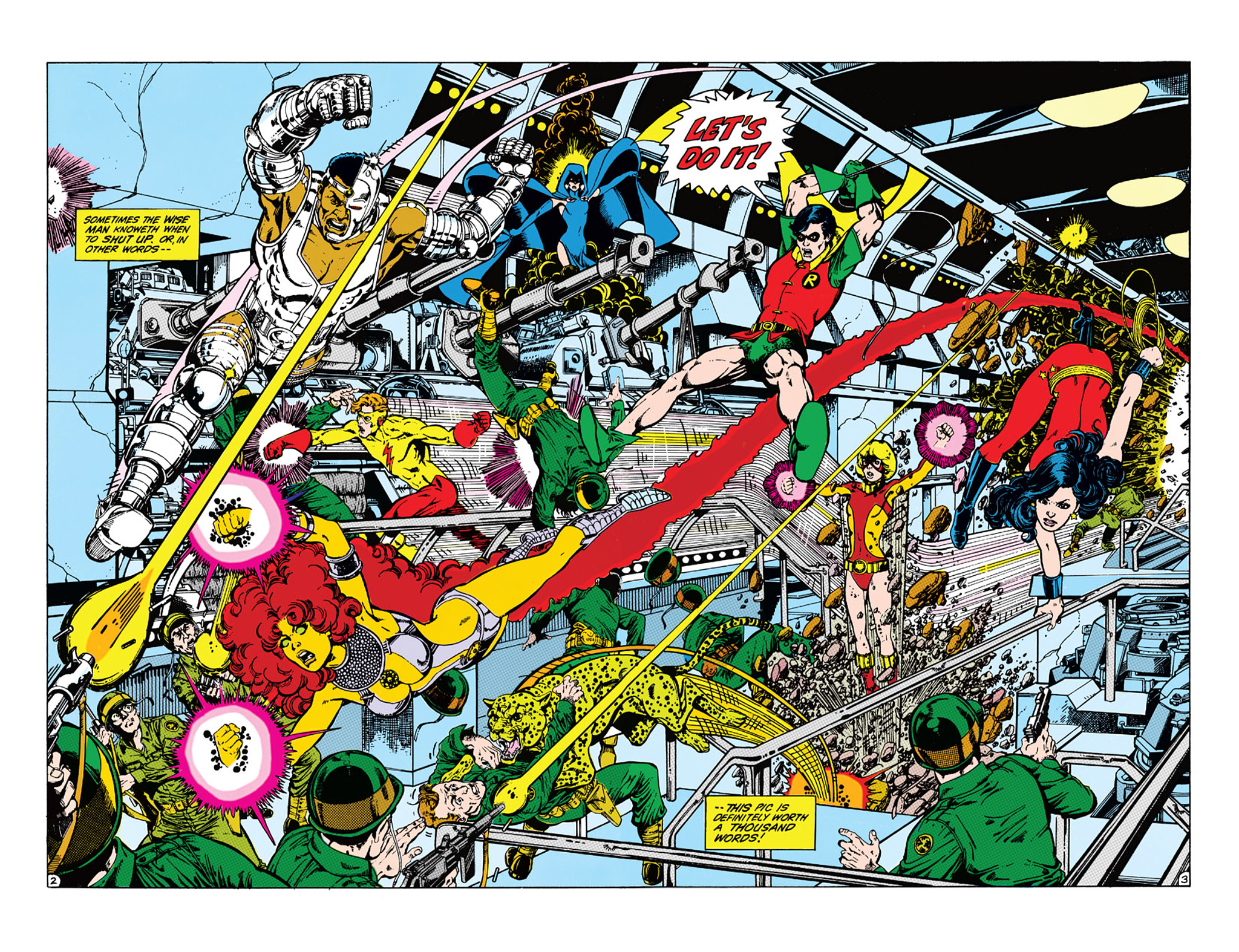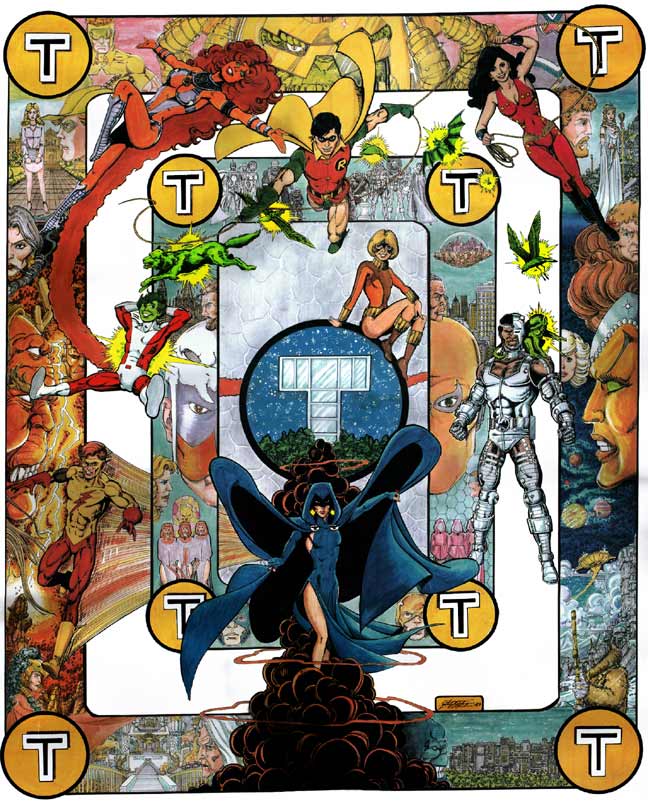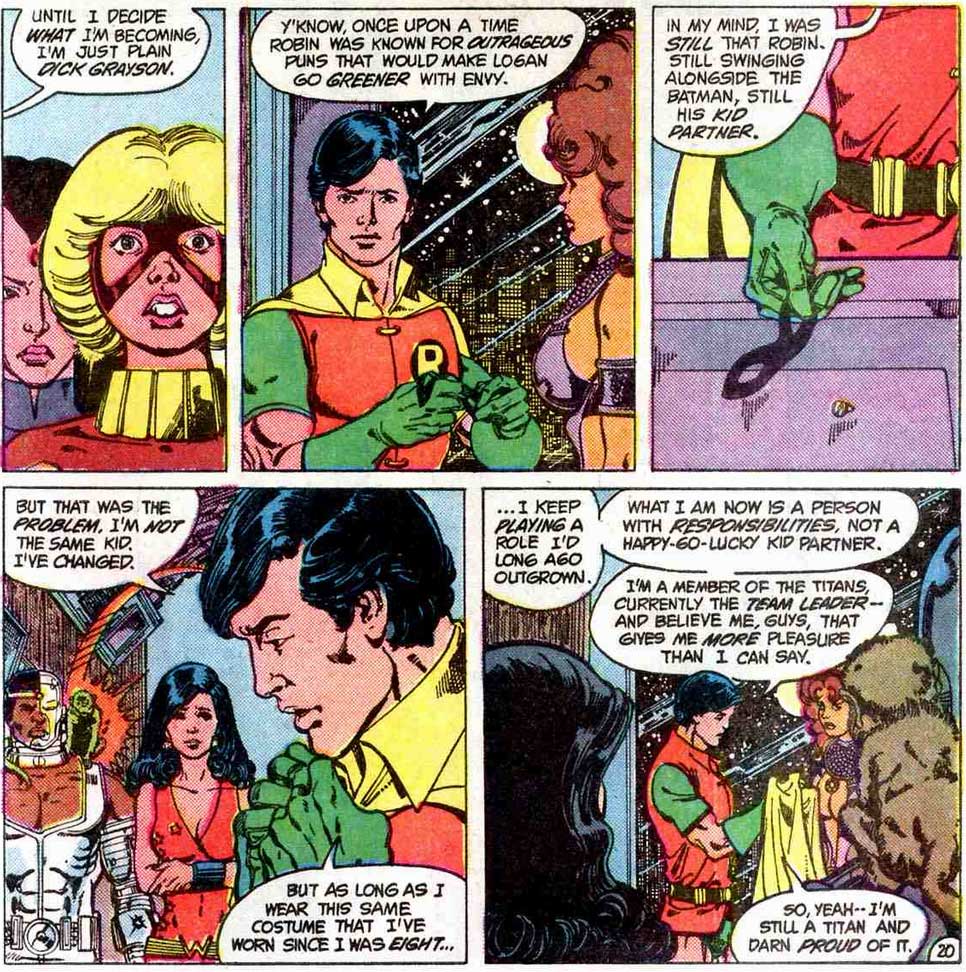 Last month, at some point, I wondered aloud on Twitter why Marv Wolfman’s 15-and-a-bit year run as writer on New Teen Titans/New Titans hasn’t been given the same critical re-appraisal as Chris Claremont’s 16 years as X-Men writer. People responded with a number of suggestions, but having just spend a weekend reading New Teen Titans Omnibus Volumes 1-3, I think I’ve managed to pinpoint the problem: Titans peaked far, far too early.
Last month, at some point, I wondered aloud on Twitter why Marv Wolfman’s 15-and-a-bit year run as writer on New Teen Titans/New Titans hasn’t been given the same critical re-appraisal as Chris Claremont’s 16 years as X-Men writer. People responded with a number of suggestions, but having just spend a weekend reading New Teen Titans Omnibus Volumes 1-3, I think I’ve managed to pinpoint the problem: Titans peaked far, far too early.
The three omnibuses offer a snapshot of that era of the series, along with a genuinely scattered idea of what followed — the third volume, which I think rounds up the remainder of the Perez-affiliated material, includes Tales of the Teen Titans #38, 41-50, The New Teen Titans Vol. 2 #1-6, The New Titans #50-61, 66-67 and Secret Origins Annual #3… which is a pretty random assortment, really, but between this and my own earlier reading of the series (mostly Tales of the Teen Titans issues when it reprinted the Baxter series, and some of the latter Wolfman/Tom Grummet New Titans issues), I feel like I have a pretty good handle on what followed that initial Wolfman and Perez run, and it’s not as good.
Which sounds more damning than it’s intended to be; I have really fond memories of a bunch of the Wolfman/Barretto issues, including the second coming of Brother Blood and my first meeting with Hank Hall, AKA the one true Hawk, for example. But despite how poorly they’ve dated — and they have dated very poorly in places — the first 40-50 issues of New Teen Titans have this jittery, infectious excitement that makes them supremely enjoyable to read. There’s a tangible energy of discovery as Wolfman and Perez start realizing that they’ve got an audience and egg each other on to new japes.
 There’s nothing very groundbreaking in those issues — I think Jeff’s argued on the podcast as some point that what makes early NTT so exciting is that it successfully brings the Marvel feel to DC for the first time, and there’s definitely something to that. But in terms of plot, there really isn’t anything that readers hadn’t seen before: My father is a demon! We’re in space fighting aliens! One of the team is a traitor!
There’s nothing very groundbreaking in those issues — I think Jeff’s argued on the podcast as some point that what makes early NTT so exciting is that it successfully brings the Marvel feel to DC for the first time, and there’s definitely something to that. But in terms of plot, there really isn’t anything that readers hadn’t seen before: My father is a demon! We’re in space fighting aliens! One of the team is a traitor!
(I’m weirdly fascinated by the fact that “The Judas Contact” and X-Men‘s “Dark Phoenix Saga” both involve the team betrayed by one of their number, and happen around 40 issues into the run; were Wolfman and Perez consciously aping Claremont and Byrne, or was this just coincidence?)
What makes it work is that it’s done with such enthusiasm — everything is turned up to full effect, whether it’s the soap operatics (Both Starfire and Cyborg’s lovers are killed off in the stretch of a few months, something that’s even called out in the text), the melodrama of the adventure plots, where both runaways and super villain civil wars have the same breathless, everything relies on what happens next tone, and Perez (with inkers Romeo Tanghal and Dick Giordano, the latter doing some great work) offering up visuals that are almost parodically slick and perfect 1980s eye candy — and yes, the costume designs and hair styles really do place the book firmly in the era in which it was created.
There’s a feeling that each successive arc in the first four years of the series is building on what came before; a sense of oh, they liked that? Well, wait ’til they see this — no mean feat, considering the first arc was about a demon who wanted to rule all of humanity — until the series peaks with the end of “The Judas Contract.” The problem is that it never quite regains its mojo after that. There’re nice moments as the aftermath of that arc are explored at (surprising) length, and the wedding of Donna and Terry Long* is cute in a meta way, but that’s it; the next big arc is a re-tread of the first Trigon storyline, and the book increasingly loses both direction and intent even within that arc. By the time Perez moves on afterwards, and even when he returns years later, the momentum has gone.
It makes sense, perhaps; the Wolfman/Perez team maybe just reached the top and they had to stop (on Titans, at least, with Crisis on Infinite Earths taking up their collective time instead). I’m not quite sure where Titans could have gone post-“Judas,” and find myself thinking about X-Men‘s similar wilderness period after “Dark Phoenix,” which lasted for… what, two years, with occasional highlights? I feel like the book didn’t really find a groove again until Paul Smith came along. Wolfman would go on to work with a bunch of great artists on Titans after Perez — there’s a Jose Luis Garcia-Lopez run in there! — but at its best, on those first 40 or 50 issues, it was a book that always felt like more of the sum of its creators’ parts than X-Men managed. Once Perez left, the book became something else — arguably just as interesting, if not as good — but Wolfman’s Titans was a different series altogether.

This is my… third? fourth? attempt to get through these issues, and the first time that they’ve really clicked for me; maybe it just required really immersing myself in the material to this extent, or perhaps I was just in the right frame of mind this time around. But I feel like I get this part of superhero comics history now, to the extent that I feel a little sad that it fell apart quite so quickly. If there’s ever an omnibus of the book’s latter attempts to reclaim this feeling (The “Titans Hunt” storyline, around the series’ 10th anniversary, comes closest, I seem to remember), I’d be fascinated to read that again and see how it measures up. Before then, though, I’m going to take a dive into the New 52 version of the team…
* If there’s something about this run that really stands out in a “You know, that’s kind of fucked up” sense now, it’s the older-man/younger-girl romance dynamic at play. Not only in the 29-year-old Terry Long, who sweeps the… let’s be generous and say 18-year-old Donna Troy off her feet despite looking ridiculous and having no personality whatsoever, but also the far-more-creepy Deathstroke/Terra relationship. She’s, what, 15 and his son is older, and yet there they are, fucking in between her missions undercover as a Titan. I know they’re meant to be evil and all, but I can’t believe no-one thought to step in and say, “you know guys, statutory rape isn’t a good look for this book” at least once.


The original run of New Teen Titans is a classic and I enjoy it as much as Claremont’s X-men. But once Perez is off the book it never gets back to the heights it had when Perez was there consistently. The Wolfman run after with the deluxe book had some interesting ideas and occassional story points that had glimmers of the older stuff. But it never approaches the heights of NTT from the 1st issue to The wedding of Donna Troy. (The book really peaked with the Origin of Donna Troy in 39). Titans Hunt had some interesting plotting and great Grummett art but went on longer than needed and the book never was the same with all the meandering plotlines that never ended. Part of my love for the Perez stuff is based on nostalgia but I still feel those books hold up well. But when compared to Claremont and his run Wolfman looks like a pale copy of Claremont. Part of that is Claremont had a great run on X-men and benefited from the art changes which allowed him to plot stories geared to his artist’s strengths.. Wolfman always seemed to be plotting like he had Perez but had stories that were drawn by artists with syles that did not fit the stories he was writing. Which is sad considering the artists were Garcia Lopez, Barreto and Grummett among others.
Two reasons why X-Men worked better than Teen Titans:
1) Claremont stayed on X-Men for 17 years, but the variety of artists he worked with made each run unique. Dave Cockrum X-Men, John Byrne X-Men, Paul Smith X-Men, JR Jr X-Men, Marc Silvestri X-Men, and Jim Lee X-Men all have distinct looks and feels. The stories and settings were widely varied. Teen Titans, meanwhile, was defined by the Wolfman/Perez synthesis. Everything that came after was not Perez, but hit the same or similar story beats and thus felt off. I think the Marvel method (which was adapted by Wolfman and Perez) has something to do with X-Men’s success outlasting TT’s.
2) The cast of Giant-Sized X-Men 1 was great, and most of the X-Men added since had staying power. Claremont changed the rosters a few times, too; Cyclops, Nightcrawler, Colossus, Banshee, two Phoenixes, Angel, Shadowcat, Magneto, Dazzler, Longshot, and Havok cycled through the series while only Storm and Wolverine were constants. Later members like Rogue and Psylocke managed to stick around once introduced. The Titans, meanwhile, started with a great line-up and did little to change it. Wolfman introduced new characters, eventually, but almost all of the issues were about the (mostly good) characters who showed up in NTT 1. His new characters weren’t as good or memorable as Rogue, Shadowcat, or even Gambit. Most of them are barely remembered or downright loathed (Danny Chase, anyone?).
No joke, the theme song by Puffy was on my pre-race iPod mix.
I’ve read the first omnibus only so far and that was a while ago and like Graeme, it took me a while to get through it. I stopped and started over a period of a year or so and then got into a groove and blew through it. And like you all, I found myself comparing it to Claremont’s X-Men, and while I’ve seen some opinions that Wolfman & Perez’s New Teen Titans was better than Claremont’s X-Men, I just can’t agree with that. I really enjoyed New Teen Titans and actually hope to continue reading the run – at least up until maybe the Judas Contract – but X-Men of that era was simply better for a number of reasons. Claremont had a firm grasp on his characters and provided very distinct personalities to most of them, plus he did a better job of integrating large casts of rotating characters who would come and go over the years. It felt more like real life in that way than most books of that era. And while Claremont is famous for his purple prose, it’s still pretty fun to read and flows well most of the time. Wolfman dialogue and narration, by contrast, was often a slog to read in my opinion. And back to the earlier points, Wolfman didn’t do nearly as good a job at integrating a large cast of rotating characters nor did provide his characters with personalities that were as distinct as those of the X-Men. Some of the Titans had strong characterizations, but some of them were relatively weak when compared with the X-Men.
I’m making it sound like NTT was no good but that’s not true at all. It was immensely enjoyable and I can see why it was so insanely popular during that era. Graeme hit the nail on the head: the book positively vibrates with energy and you can feel it through Wolfman’s and Perez’s work on the book. They were in a groove together and it’s incredibly exciting to read.
“Not only in the 29-year-old Terry Long, who sweeps the… let’s be generous and say 18-year-old Donna Troy off her feet despite looking ridiculous and having no personality whatsoever, ” Egads that’s all so on point. The Terry Long storyline is cringe worthy. And then the Deathstroke fucking Terra thing is just downright sick. I realize it was a different era but I am still surprised that an old dude screwing a 15 year old wasn’t seen by editorial as just taking things too far. And my goodness is Terra’s story sad. While I haven’t read the Judas Contract yet it was spoiled for me ages ago, and to think about her arc over the series is just so depressing. It makes me sad to think of a young female character being created just to be put through the ringer of mental illness, being preyed on emotionally and sexually by an older man, and ultimately (spoilers!) a sad demise.
By the way, this run is being recollected by DC at the moment in very affordable trade paperbacks. I think the first three volumes collect everything that was in volume one of the omnibus, so I’m hoping to pick up the volume 4 paperback when it comes out later this month to continue the reading experience.
I just picked up the 3 trades that were released and I’m hoping to dig in this weekend, I’ve only read bits and pieces of the series over the years so I’m looking forward to it.
I went through those 3 omnibuses (omnibi?) recently as well, because I remembered NEW TEEN TITANS fondly from being a kid (It, LEGION, and X-MEN were the three books I can remember following first) and I came a similar conclusion that you and a few of the other commenters had come to: Teen Titans flamed out because it peaked far too soon, and Wolfman didn’t have Chris Claremont’s skill at adapting his storytelling style to artists that weren’t George Perez.
What’s more, Wolfman has a tendency to back the wrong horse in terms of recurring plots (there’s a lot of focus on Raven, and the more time we spend with Raven, the more we learn that nothing about her makes any sense and yet, he won’t leave her alone. Terry Long and Donna Troy never stops being gross, and while I suppose I can give them some credit for trying something different with Jericho being polyamorous, it doesn’t follow that Jericho is that interesting and it’s more an accouterment to hang on the character to make them seem more interesting than they are.
And we spend far too much time going down these blind alleys, the book never evolves as much as recycles, and couple with the Baxter split, it pretty much killed the spontaneity of the book.
Main difference is that Claremont/X-Men always sucked even at its best as Claremont was just a pisspoor writer who repeated the same tropes and tics over and over, not to mention the repetitive tone-deaf dialogue where if one were to hear it recited without the visuals and balloons you’d never know who was speaking because they all sounded the same aside from the occasional fake German or Russian tossed in to remind us that some of the heroes were foreigners. Contrast with dialogue in New Teen Titans where one can immediately tell, for instance, yeah, that’s Cyborg’s voice, yeah, that’s Raven, yeah, that’s Changeling. Additionally, after Cockrum left he was saddled with Byrne as artist. Byrne, the guy who repeats the same stock poses ad nauseam. The guy who can draw one female face with different hairstyles. The guy who can draw one female body type. Yeah, that Byrne. He’s no Perez. So with shitty art and writing, X-Men’s supposed greatness is just a myth.